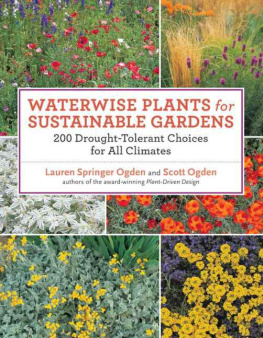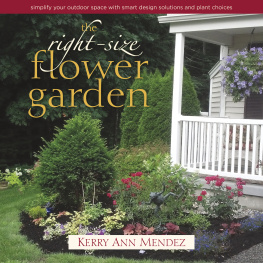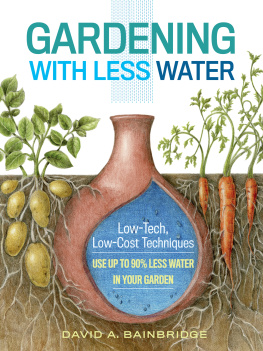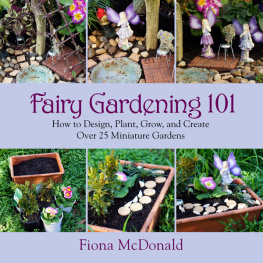

HOT COLOR, DRY GARDEN
Inspiring Designs and Vibrant Plants for the Waterwise Gardener
NAN STERMAN
Timber Press Portland, Oregon
This book is dedicated to my husband, Curt Wittenbergmy sweetie, my life partner, and supporter of all my dreams; to Gabe, Asher, and Tamar, the up-and-coming gardeners of the world; to Grandpa Eddie, who never got to be a farmer; and to Jan Smithen, my dear friend and inspiration.


Contents
ACKNOWLEDGMENTS
Thanks to designers Scott Calhoun, Judith Phillips, Patrick Anderson (yes, Patrick, you are a designer), Nick Wilkinson, Gabriel Frank, Nick Dean, Dustin Gimbel, Leslie K. Dean, Judy M. Horton, Amelia Lima, Laura Morton, and Alan Richards for creating the beautiful, color-filled, waterwise gardens that inspired this book and will inspire its readers. Thanks also to Santa Rosa landscape designer Michelle Bellefeuille, who passed on during the production of this book (see her garden on ). Michelle was one of the most gifted and thoughtful designers Ive ever met. She was soft spoken and quiet, but with an aura that drew people to hersimply put, she glowed. Being around her was magical and I cant imagine not seeing her again. I hope featuring her gardens on these pages serves as a tribute to her accomplishments and a lasting memory of her lovely presence.
Thank you to all the designers and garden owners who allowed me into their private spaces to photograph and share their gardens. Thanks also to Glenda Garmon, Andrea Testa-Voight, Cheryl K. Lerner, Carol Anne McDougal, Dinah Grisdale, Macon McCrossen, Annette Gutierrez of Potted, Debra Carl, Scott Spencer, and Maggie Judge. Your generosity paves the way for others who are contemplating this important shift from thirsty, wasteful gardens to waterwise, resource-thrifty, and beautiful, colorful gardens.
Thanks also to the designers and homeowners who allowed me to shoot gardens that unfortunately ended up on the cutting room floor. With more gardens than pages, deciding which to feature and which to leave out was a tremendously painful process. Please be assured that your efforts were not wasted. Your gardens serve as examples in the many talks and presentations I give.
Thank you to all the garden designers, horticulturists, and gardeners who reviewed plant lists and shared their plant knowledge from microclimates across the West: Wendy Proud, Karrie Reid, Bracey Tiede, George Hull, Brian Kimble, Richard (RG) Turner, Janet Sluis, Pete Villeux, Randy Baldwin. Thanks especially to Judith Phillips and Scott Calhoun. Thanks also to Hunter Ten Broeck for sharing your time and vast expertise. Thanks to three very special women. Landscape designer Linda Chisari unwittingly started me down this path when she introduced me to the term dry garden when we first met in 1992. My dear friend, author and gardener Jan Smithen, has shared her enormous knowledge over the many years that we have known one anotherher great enthusiasm inspired my own. Finally, long ago, when a door closed, Mary Hellman James opened a window and pulled me into her world. I am eternally grateful to her for that and for her many years of friendship and support.
The biggest thank you goes to my family for their patience, love, and support, and for indulging me in this plant passion that has been my driver for so many years. Please know that you are far more important than any plant Ive ever come across.
INTRODUCTION
Drought, drought, and more droughtdry weather, of course, is to be expected in most of California, Arizona, Utah, Nevada, and New Mexico, but it is only getting worse. Recent years have brought the worst drought California has ever experienced, and along with it a wide array of mandatory water cutbacks. Arizona and California seem perpetually mired in battles over the water of the Colorado River. That water will diminish as climate change promises hotter temperatures and reduced water supplies across the West.
Drought has been an issue in the Southwest for a long time, but increasingly across North America and around the globe, population growth and global warming are making water more and more a focus of sustainability. And as water becomes more precious, gardens suffer. We need to make significant changes in our aesthetics, our attitudes, our plant choices, and our gardening practices.
This is what Ive spoken, taught, and written about for decades. And throughout that time, Ive found that gardeners biggest fear of waterwise gardens is the misconception that these are brown, lifeless, and colorless gardensbut nothing could be further from the truth.
Low-water gardens buzz with life. They are bright, brilliant, colorful gardens with as much interest and varietyand in some ways morethan any other gardens. In fact, color and low water go hand in hand. This is something Ive known intuitively for many years. I trace it back to a trip my husband and I took to Santa Fe, New Mexico, long ago. We walked up Canyon Road (a street now infamous for its profusion of artist studios), and as we strolled, I kept noticing the gardens. They were modest, some simple, narrow planting beds tucked up against adobe walls and holding just a few plants: a red- or pink-flowering penstemon perhaps, with a blue-flowering cornflower and a trio of royal purple bearded irises. There werent many flowers, but they stood out as brightly and distinctly as if there were an entire mass of color. The bright greens, silvers, purples, blues, pinks, and yellows that filled those beds lit up in the desert sun.
In the years since, Ive thought often about those tiny, dry gardens and the huge visual impact that resulted from the combination of three factors: the flowers and leaves were deep, intense, saturated colors, while the background earth tones were equally rich, and the sky was a clear, bright, intense blue. Together, the effect was dazzling.
Common Misconceptions About Low-Water Gardens
In my travels throughout the Southwest, Ive visited countless color-filled, low-water gardens. It is high time that we set the record straight about what can be achieved, even with increasing water constraints.
Three central myths about waterwise gardening need to be corrected straight away.
Myth #1: Low-water landscapes are brown, lifeless, and colorless
Low-water gardens are anything but brown, lifeless, and colorless! In fact, plants from dry regions of the world seem to evolve the most colorful and interesting flowers, the most varied and colorful leaves, and attract an amazing array of wildlife.
My own garden and those I design for clients are filled with riotous colorhot colorsalive with butterflies, lizards, rabbits (though I wish we could get rid of them), and birds, including the ever-present hummingbirds whose iridescent throats glisten garnet and emerald as they dart about the garden.
People are amazed to see the color and variety. Not long ago, I appeared on a local television program to talk about waterwise gardening. I arrived at the studio with my truck full of plants, and assembled the display to demonstrate several color themes. The public relations person who arranged my appearance had a decent grasp on the concept of a low-water landscape, but wasnt herself a gardener. She was absolutely amazed by the rainbow of colors in my show display.
Next page









